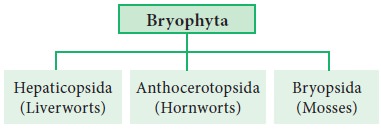Chapter: 11th Botany : Chapter 2 : Plant Kingdom
Classification of Bryophytes
Classification of Bryophytes
Proskauer in the year 1957 classified Bryophytes
into 3 Classes namely
i. Hepaticopsida
(Riccia, Marchantia, Porella and Riella) ii. Anthocerotopsida (Anthoceros
and Dendroceros) iii. Bryopsida (Funaria, Polytrichum and Sphagnum).
The outline of the classification is given below

Class: Hepaticopsida
They are lower forms of Bryophytes. They are more
simple in structure than mosses and more confined to damp and shady places.
They have an undifferentiated thallus. Protonernal stage is absent. Sporophyte
is very simple and short lived. In some the foot and seta are absent. Example Riccia.
Class: Anthocerotopsida
Gametophyte is undifferentiated thallus. Rhizoids
are unicellular and unbranched. Protonemal stage is absent. Sporophyte is
differentiated into foot and capsule and seta is absent Example: Anthoceros.
Class: Bryopsida
![]()
![]()
![]()
These are higher forms in which the gametophyte is
differentiated into ‘stem’ like and’leaf’ like parts and the former showing
radial symmetry. Rhizoids are multi-cellular and branched. Protonemal stage is
present. Sporophyte is differentiated into foot, seta and capsule. They have a
more differentiated structure than liverworts. They often form dense cushions.
Example: Funaria.
Related Topics